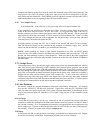
5-2H A-Frame Sub-Assembly
Verify that the A-Frame assemblies have not moved and that the bolts have not loosened due to vibration.
5-2I Electrical Power Box and Mitsubishi Transistorized Inverters
Check the following:
1) Cooling system: Clean air vent, fan, filter, etc.
2) Screws and bolts: These parts may become loose due to vibration, temperature changes. Tighten as
necessary.
3) Conductors and insulating materials: Check for corrosion and damage.
4) Inverters: Cooling fan, smoothing capacitor, relay, check and change if necessary.
5) Check circuit protecting contactor and thermal overload relay (OLR) by using the TEST and
RESET buttons. See attachment for contactor and OLR information.
5-3 Mitsubishi Transistorized Inverter Maintenance
Replacement of parts
The inverter consists of many electronic parts such as semiconductor devices. The following parts may
deteriorate with age because of their structures or physical characteristics, leading to reduced performance
or failure of the inverter. For preventive maintenance, the parts must be changed periodically.
(1) Cooling Fan
The cooling fan cools heat-generating parts such as the main circuit semiconductor devices. The life of the
cooling fan bearing is usually 10,000 to 35,000 hours. Hence, the cooling fan must be changed every 2
to 3 years if the inverter is run continuously. When unusual noise and/or vibration is noticed during
inspection, the cooling fan must be changed immediately.
Removal
1) Push the catches on both sides and pull the fan casing down.
2) Disconnect the fan power connector.
Reinstallation
1) Reconnect the fan power connector.
2) Push the fan casing up until it locks into place.
(2) Smoothing Capacitors
A large capacity aluminum electrolytic capacitor is used for smoothing the DC in the main circuit and an
aluminum electrolytic capacitor is also used for stabilizing the control power in the control circuit. Their
characteristics are adversely affected by ripple current, etc. When the inverter is operated in an ordinary,
air-conditioned environment, change the capacitors about every 5 years. When 5 years have elapsed, the
capacitors will deteriorate more rapidly. Check the capacitors at least every year (less than six months if
their life will be expired soon).
Check the following:
1) Case (side faces and bottom face for expansion)
2) Sealing plate (for remarkable warping and extreme cracks)
3) Explosion-proof valve (for excessive valve expansion and operation)


















